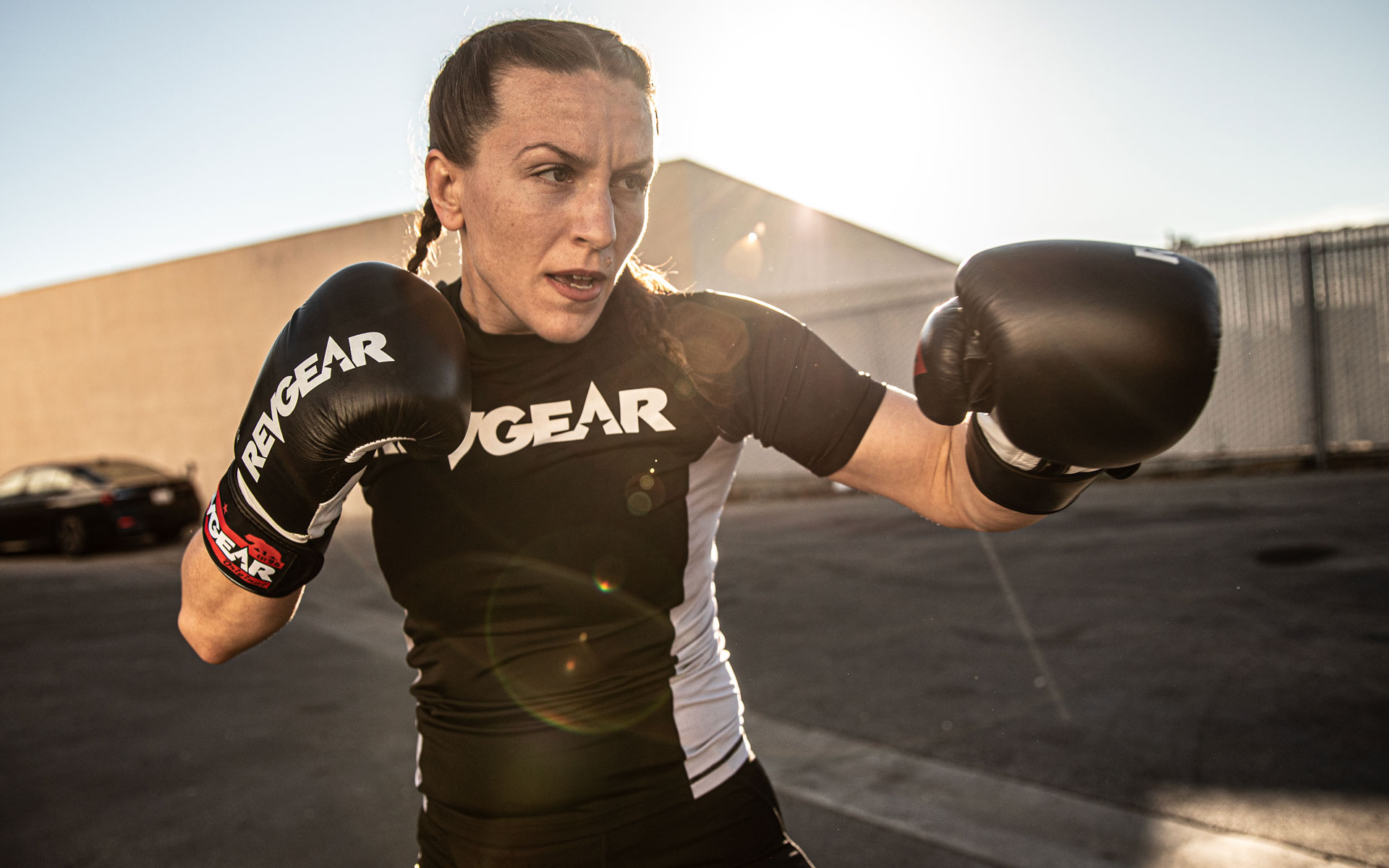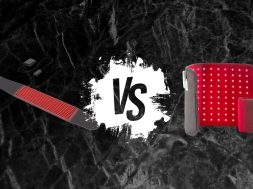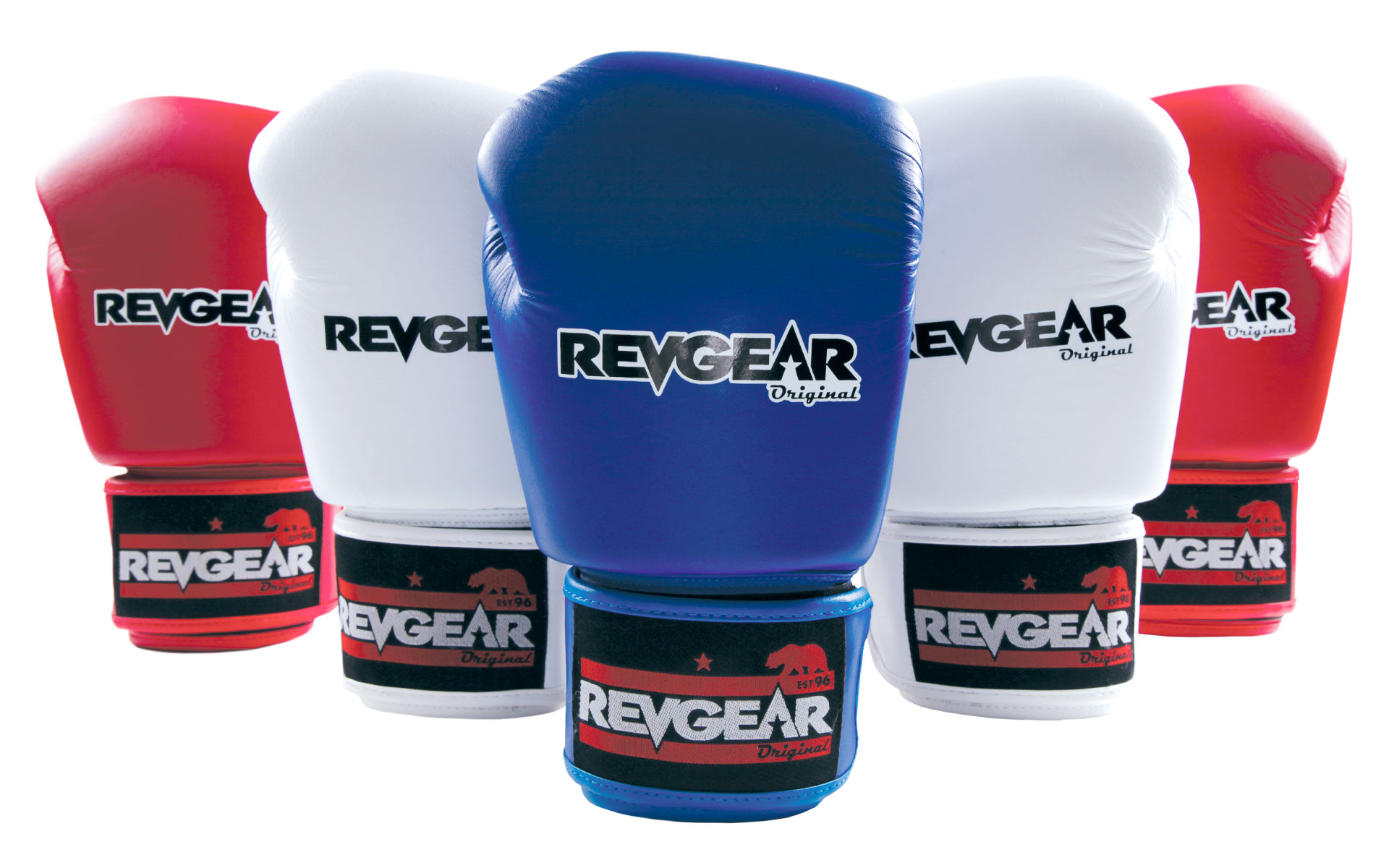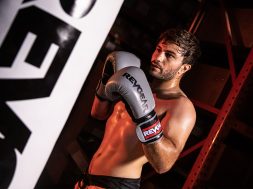
Revgear’s Ultimate Guide to Boxing Gloves
Questions about boxing gloves? Look no further: Revgear answers all your questions
You have taken the first step and started to train in a striking martial art. Now it’s time for you to get a pair of boxing gloves that you can have confidence in. But how do you choose the best boxing gloves for you? What are the right size boxing gloves? What kind of boxing glove should you consider? With so many gloves out on the market, it can be a difficult choice to make. This comprehensive guide to boxing gloves clears up any questions you might have, from sizing and type, to construction and color. After years of being asked questions, we have put together the ultimate boxing glove Q+A sheet. Everything you ever wanted to ask about boxing gloves is answered here.
What is the best weight for boxing gloves?
Many people get confused when answering what is the best weight for boxing gloves? There are a few factors you need to consider when making this decision. The first is your weight. If you are a smaller person, you may want to wear lighter gloves. Youth gloves are often around 8oz, for example. A heavyweight may need to wear a much larger glove for sparring, such as an 18oz. On the whole, the average person will need to use gloves in the 10oz to 16oz range.
Within this range, different glove weights have different purposes traditionally. For sparring, most gyms will insist upon a 16oz glove. This weight offers more padding, so it is less likely to injure your partner or yourself. When hitting the bag or pads, a 10oz glove is a better choice, as you can move more quickly and get better hand conditioning. Although they have become less common over recent years, 4 or 5 oz bag gloves are a great option for hitting the heavy bag as they are cheaper and you can beat them up without breaking the bank, while getting superb hand conditioning.
10oz gloves tend to be the average weight used in professional fights. Light weights may use 8oz gloves and heavyweights 12oz, but the most common are the 10oz. If you are looking to compete in your gloves, then see what the competition requirements are within the organization you intend to compete in.
Traditionally, because of all these factors, fighters have tended to have a range of different gloves for different purposes. They would likely have 4-8 oz bag gloves, 10oz or 12oz gloves for pads and mitts, and 14oz or 16oz gloves for sparring. Most people don’t want to have to carry this many gloves to the gym and back every time, or don’t have the resources to buy multiple pairs of gloves. Luckily, gloves such as the Revgear S5 All Rounder combine all the best features of the different types of glove so that you can have it all in a single, hardwearing, but comfortable glove.
How much does a boxing glove cost?
The price of a boxing glove varies greatly. A cheap sports store model will cost you as little as $20, but expect to get what you pay for. Some of the highest end models can set you back well over $500, but most people will never need to buy a pair in that price bracket.
On average, a more affordable glove will cost around $40 to $60, while a more premium model is priced between $80 to $150. This is all dependent on the materials used in the construction of the glove and other factors involved in the manufacture and branding process.
Why are some gloves more expensive?
The pricing of boxing gloves depends on a number of factors. Some brands charge more simply because people are willing to pay more for them. Often, some of the super high end brands are producing the same quality as many of the mid-priced brands. Eliminating this, the main factor when it comes to pricing is the construction materials.
Boxing gloves are all made by hand, as the stitching and putting together of a glove cannot be done by machine. This means that labor cost isn’t as important as material cost, as most gloves require the same amount of labor to make. The two main areas to think about are the exterior material and the filling.
Leather costs more than synthetic materials, and the higher the grade of leather, the higher the price. The stuffing can be foam or horse hair. Horse hair is the most expensive, but fairly rare these days, only being used by bespoke makers. Higher density and quality of foam increase the price too.
Ultimately, an expensive glove is of a higher quality. The better the glove, the more expensive it is. Some gloves cost a lot because they are made to order, so are expensive because the brand has positioned itself to be able to command a higher price regardless of quality.
What are the different types of boxing gloves?
There are several types of boxing gloves each of which has a different purpose. Some gloves are multipurpose.
Bag gloves have less padding and are made with the sole purpose of hitting the heavy bag. They are used by people who want to save their other gloves from taking a beating on the bag. They are a good affordable option for this purpose. An added bonus of using bag gloves is that the thinner padding on the glove allows for more rigorous hand conditioning.
Sparring gloves, like the REVGEAR velcro Sentinel S3s or lace-up S4s are designed to be used while sparring. They offer plenty of protection and support while being large enough not to badly injure your training partner. The 16 oz weight glove is the standard size used for sparring. Sparring gloves can also be used to hit the pads and bag as well and the S5 All Rounder is designed to be used for all three applications.
Pro gloves, like the F1 Competitor, are designed to be worn in the ring for professional or semi-pro fights. They are always lace up and either 8 or 10 oz. They have less padding than a sparring glove so that you are able to do more damage to your opponent. This kind of glove can be worn in the gym, but is best suited to padwork, rather than sparring. The lighter weight and smaller profile make it a great option for hitting the mitts.
What safety features to look for in a boxing glove?
A boxing glove is designed to keep your hands safe. While all gloves do this to some degree, there are a few safety features to look for in a boxing glove. The first is more general: does the glove fit well on your hand, allowing you to make a good fist. The fit is the first safety feature. If the glove is built right, it will allow your hand and wrist to come into correct alignment.
The next thing to look for is good wrist support. Whether lace or velcro, the most important thing is that the wrist locking system fully wraps around your wrist and connects so that it is not too loose. This means that you are unlikely to turn your wrist while punching.
The final feature to look out for is the thumb connector. Gloves should have a small strap of leather that connects the thumb to the other fingers. This can either run the length of the thumb, or just connect the top to the rest of the glove. Either works, but if this feature is missing, or the connector is too long or loose, then the thumb can stick up and get caught while punching. This makes injury more likely, as the thumb can get pulled back.
Ensure that the glove fits well with good wrist support and a strong thumb connector.
How should a boxing glove fit?
How should a boxing glove fit? While there is some level of preference in the answer to this question, there are a few factors that need to be addressed in terms of the fit. The inner part of a boxing glove is known as the hand cage in the industry. This is often designed to fit a hand that has been wrapped. A bare hand, as opposed to one protected with a hand wrap is smaller, so if you find that your glove is a little loose with just your hand inside, consider wearing wraps.
On the whole, a glove will feel tighter when you first purchase it until you have stretched them out into what is affectionately known by fighters as a “broken in feel.” So if you put brand new gloves on and they feel a little tight, they will soon fit you like a proverbial and actual glove.
The main factor to bear in mind is whether you can make a fist. Some lower end gloves can have a strange fit where you can’t close your fingers and thumb into a fist, leaving you with a claw-like open hand. This is something to look out for and avoid, as it can lead to all sorts of hand and wrist injuries.
How long does it take for a boxing glove to wear out?
How long it takes for a boxing glove to wear out depends on three main factors: the construction material, the way it is used and how often it is used.
Gloves can be made of synthetic or leather outers and a variety of different foam or traditional stuffings. On the whole, leather lasts longer than synthetic material. With the advances in technology, the durability of synthetics is beginning to become more on par with leather, but there are a few reasons why people are willing to pay more for a leather glove: they usually last longer, feel nicer and mold better than most synthetic gloves.
Foam is the standard for boxing gloves these days, and you will only find traditional horse hair gloves from bespoke glove makers. The density and durability of the foam is normally reflected in the price point, but many of Revgear’s more affordable ranges have the same high quality foam as the higher end.
If a pair of gloves is being used for sparring, bagwork and padwork, then they are going to get beaten up more quickly than a pair of gloves used exclusively for one or other of the activities. On the whole, badwork is the most wearing on a glove and sparring is the least. This is why boxers and martial artists traditionally used bag mitts for hitting the heavy bag.
The final factor is how often the gloves are being used. Someone training five days a week is going to go through gloves much quicker than someone training once or twice a week. If you train intensively, expect to buy gloves more often than if you train less rigorously.
Taking these three things into account, a pair of gloves will likely last you between 6 months and 3 years. If you choose to use one pair of well-made gloves and train three times a week, then you should get 12 – 18 months of good use out of them until they begin to degrade.
What boxing gloves do pros use?
Pro fighters use several different boxing gloves depending on their situation. A pro will tend to use bag gloves on the heavy bag and sparring gloves for sparring and mitt work.
Once in the ring, a pro fighter will need a pro glove like the F1 Competitor. Depending on the fighter’s weight, the glove will vary from 8 oz for small people and 12 oz for heavyweights. The most common weight is 10 oz, which covers most weight divisions.
A pro glove is built differently from a sparring glove. It is not only lighter weight, but there is less padding so that each shot lands with more impact. A pro glove is also a more streamlined profile and has a very balanced weight distribution. They are made to move quickly and through smaller gaps. Each punch lands harder due to the thinner padding.
Should I use 12 or 14 oz boxing gloves?
You may be asking should I use 12 oz or 14 oz boxing gloves? These are both a somewhat in-between weight of glove, with 10oz gloves being more conventional for hitting the mitts and 16oz more common for sparring. If you are a bigger person, you have more power on the whole, so a 12oz glove may be a better bet for hitting the pads, so you can get better knuckle protection.
If you are a smaller person, then you may not need so much padding while sparring and could benefit from having a lighter glove so that you will tire less quickly. In that case, a 14 oz glove may be what you need.
If you are an average sized person with experience and control while sparring then you can get away with a 12oz or 14oz boxing glove so that you can use it for both sparring and padwork. Many gyms will have weight stipulations for sparring gloves though, so check with your instructor about what the rules are where you train.
Check out some great examples of Boxing gloves available in both 12 and 14 oz here
Do boxing gloves come in different sizes?
Both weight and shape determine the size of a boxing glove. The material a glove is made from and the design are key factors.
The standard weights of boxing gloves are 8 oz, 10 oz, 12 oz, 14 oz, 16 oz, and 18 oz. 8’s are normally for children or lightweight pro flights, 18s are for heavyweight sparring, leaving the 10 to 16 range as the more usual adult weight range.
Aside from the standard weights, the material a glove is made from determines the physical size. There is some variation between brands and producers, but cheaper gloves often tend to be bulkier, as they use lower density foam. This means it takes more of it to get a glove up to weight. Traditional horse hair gloves can also be a little larger in size.
Modern gloves made by a good manufacturer use higher density foam, meaning that they are more streamlined in design. The key benefit of this is a better weight distribution through the glove, meaning they feel better on your hands. The low profile means you have more chance of connecting with your target when punching, without the blow deflecting.
On the whole, it is better to choose a less bulky glove in a weight that suits your needs.
Which boxing glove material is more durable?
Boxing gloves are made of both leather and synthetic materials. If you are looking for more durability, the real leather glove has been the go to choice for decades. However, synthetic leather gloves have come leaps and bounds from where they were even just a few years ago and are beginning to come closer to the durability of a leather glove.
As price is a factor, with leather gloves being more expensive than synthetic, you need to ask yourself how durable you want your gloves to be. If you are training lightly or less frequently, then the durability of your gloves is not as much of an issue than if you are training hard several times a week.
If you fall into the first category, then consider synthetic leather. If you are more like the latter, then go for real leather.
How do I take care of my boxing gloves?
You have bought your gloves and love them and now you ask yourself: how do I take care of my boxing gloves? If you want to keep your boxing gloves in the best condition for the longest time, you need to take a few easy measures to keep them tip top.
After every training session, you should spray them with a disinfectant and wipe them down inside and out with a rag. This stops the bacteria from sweat building up and making them smell. Over time, all gloves will begin to smell, but by keeping them clean, you will delay this and mitigate the issue.
When you get home, you should take your gloves out of your bag and let them dry out. Nothing builds up bacteria like keeping boxing gloves in a warm damp environment. This will also let the leather or synthetic material stay in good condition so that it doesn’t crack or break up.
If your gloves do start to pick up a smell over time, then a simple solution, if you do not have glove deodorizers, is dryer sheets. Simply put a dryer sheet in each glove when you are not using them and you can keep them smelling like fresh laundry.
What are better lace or velcro boxing gloves?
There are a few factors at play when deciding what is better, lace or velcro boxing gloves? The answer lies in what your needs are. Lace-up boxing gloves have the advantage of being tight to the wrist when tied properly. They offer an unrivalled level of support to the wrist joints and are extremely secure. The way they are padded in the wrist area also tends to make them extremely well balanced as well as comfortable to wear. The difficulties of lace boxing gloves lie in putting them on and taking them off. While there are methods of putting them on without help, they involve leaving the laces looser than optimal, so to wear them correctly, you need to have someone else tie them up for you. When you are locked in, that’s it. You cannot take them off, so you have to sip your water and adjust your mouthpiece with gloves on. There is a skill in that too, but many find it troublesome.
Velcro boxing gloves solve this problem. You can easily put them on and take them off by yourself, meaning that between rounds, you can use your hands normally to get a drink or pull up your shorts. Well made velcro gloves are almost on the level of support as lace-up, but sometimes, the velcro doesn’t stick down properly or lines up poorly on some cheaper gloves. This is most problematic in the clinch, where exposed velcro can tear up your partner’s neck.
When choosing between lace and velcro boxing gloves, you need to make sure that you understand your own needs and then decide accordingly. Make sure that if you choose a more convenient velcro model, that you get a well-made glove that will not let you down.
What is the main purpose of boxing gloves?
Boxing gloves have been around in a form we can recognise in the gloves of today since the 1700s. Their purpose then is the same as their purpose today – to protect your hands and your sparring partner.
In the early British bare knuckle boxing era, prize fights were held without the use of gloves. Bare knuckle boxing leads to hand injuries and to a lot more facial lacerations. While this was desirable to the English in the early era of boxing (and to modern bare knuckle fans), fighters and enthusiasts took measures to protect themselves while training. This is where the boxing glove began.
Known as “mufflers”, the first boxing gloves started to be made in the late 1700s. They were bulkier than modern gloves and looked more like a pair of normal gloves with a small pillow on top, but their purpose would be easily identified by anyone today. These gloves were used in training and in “sparring matches,” which were legal exhibition bouts held in various sanctioned locations.
When the Queensberry Rules were fully adopted by the end of the 1800s, thinner versions of modern boxing gloves became part of the ruleset which sought to standardize the sport. The adoption of gloves allowed fights to be easier to gamble on, as fighters suffered fewer hand injuries.
The main purpose of gloves remains the same today: to protect the hands while fighting and training and to protect the face while sparring.
What boxing gloves are used most?
The most commonly used boxing glove is a velcro sparring glove. Gloves like the Pinnacle P4 or the S5 All Rounder are the most versatile type of boxing glove, as they are made to be used in all the situations your training calls for. They are made specifically for sparring, with all the safety features you would expect from a sparring glove. However, you can also use them on the heavy bag and for pad and mitt work. This is why a sparring glove is the most popular choice of glove. The S5 was designed specifically to fit this need for one glove to do it all.
What is the best color boxing glove?
Some people ask what is the best color for a boxing glove? The answer depends on whether you are going to compete in the gloves or not. Traditionally, in Muay Thai the two opposite corners wear red and blue gloves so the judges can distinguish between the fighters. Black is often a neutral color that has been worn in the ring and white has made more of an appearance over recent years. Most competitions at the higher levels supply the gloves, and smokers, or interclubs often do not have a color stipulation for the gloves you wear, with the weight being a more important factor.
Putting this aside, if you are not thinking of competing in them, there really is no best color of boxing glove to wear. It is a personal preference. Some people prefer solid single colors, others like complex patterns. Luckily, these days there is something for everyone and there are boxing gloves produced in every color under the sun.
What shape is a boxing glove?
A boxing glove is essentially the shape of a hand made into a fist, but larger. Gloves are designed to fit the natural shape of a human hand as closely as possible, while offering protection on the outside and the ability to form a closed fist on the inside.
What is the best boxing glove? What is the best brand of boxing gloves?
There is no best boxing glove, just the best boxing glove for you. You need to figure out what your needs are and find the glove that best fits them. How often you train, how hard you train, how much sparring you do, how much bag and pad work, will you fight. These all play into choosing the best glove for you.
What boxing glove do I need to buy?
After you have answered the questions laid out above, you will then need to make the decision and pull the trigger. If you are just going to hit the bag, then bag gloves will suit your needs. If you are going to spar as well, then a sparring glove will fulfill both purposes. If you are going to be hitting the bag and pads, and sparring, then a good all round glove like the S5 is custom built for your needs.
What should I look for in boxing gloves?
Regardless of specific type of glove, there are a few things you need to think about with all gloves. These are fit, protection and construction.
The way a glove fits on your hand is one of the most important factors you would be looking for when purchasing a glove. A good glove is tight, but with room for hand wraps and should give you the ability to make a fist. If a glove hand cage is too loose or too tight or poorly shaped, you have a higher chance of injury.
Protection also plays into this, mostly in the padding and wrist support. There should be a decent dense foam or tightly packed padding that covers your hand well, without aunty soft spots or empty areas. The wrist support should not allow you to fully bend your wrist. While you will be able to move your wrist to varying degrees, the wrist section of the glove should support it fully.
The quality of construction is not just about the materials used, but also the shape and the stitching. If the glove uses good materials for both outer and inner, but the stitching fails, or the shape doesn’t allow you to punch comfortably, then the glove is not right.
Take these three factors into account regardless of what type of glove you are shopping for.


















